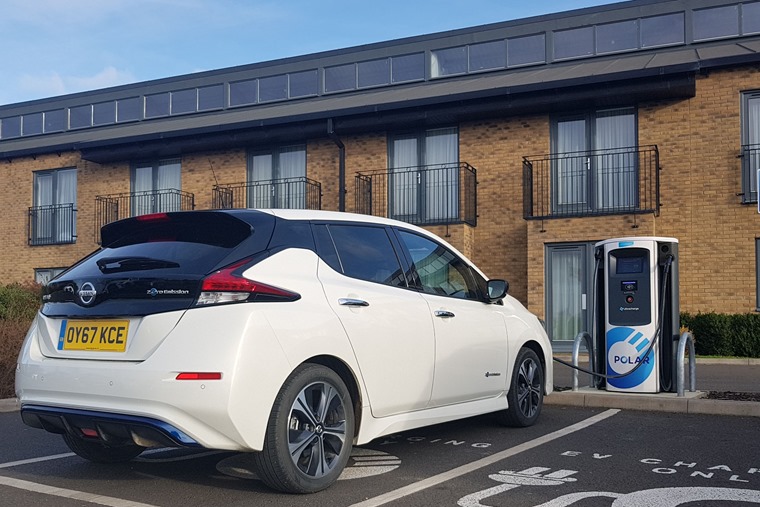Real-life review: What happens when you run out of battery in an electric car?
Range anxiety. It’s two words you’ll hear from everybody when talking about electric cars. How far can you go on a charge? How long does it take to recharge? What happens if you run out of charge?
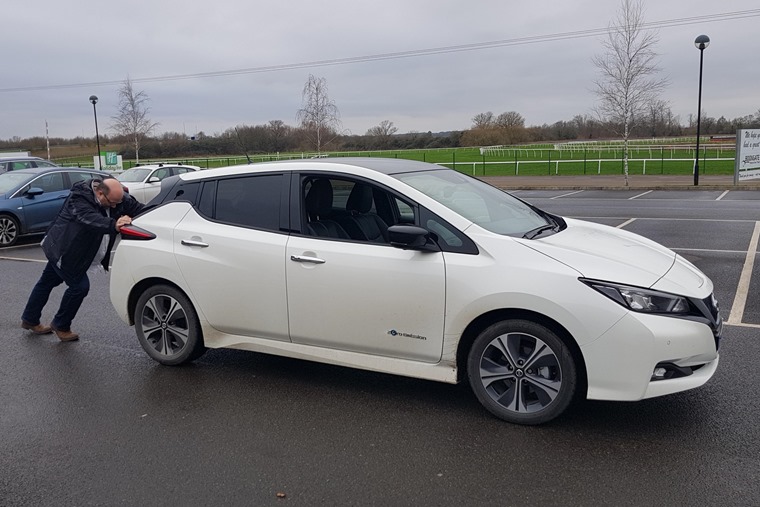
I’ve spent the last eight months driving around the country in a Nissan Leaf, a pure-electric car that has a 40kWh battery and an official range of 168 miles. That’s pretty much a best-case figure though, as driving conditions, driving style and weather play a big part in how far you’ll go in a Leaf, meaning you do have to plan a head a little.
The range available went from showing a couple of miles to the dreaded ‘---’.
The good news is that, over roughly 7,000 miles, I’ve not had a single problem with getting the car charged. It plugs in at home every night, and when I’m away I’ve always found somewhere to connect to the mains and fill the electric tank full of energy. Yes, some motorway journeys have seen me stopping for a coffee and bacon roll a little earlier than I might have done in a petrol or diesel powered car, but I’ve never been stranded with no battery power left.
Until recently, when I found out what happens when your electric car finally runs out of juice.

Compare electric home chargers
Full disclosure first, though: Running out of battery power on the outside lane of the M1 is as dangerous in a Nissan Leaf as it is to run out petrol in the same place in an Audi A6. If you do, you’re just plain irresponsible. To ensure safety, and keep disruption for others to a minimum, I planned to run out of power, and even planned where and when. This was no accident.
With a sharp jolt, the Leaf activated Turtle Power .. which cuts the power available to the bare minimum.
Which explains why I’m barrelling up and down a remote, but wide and straight, road near my house, with just 2% of battery capacity showing on the Nissan’s dashboard. That’s as low as I’ve ever dared drive it previously, so I was entering new territory. By this point the car had been warning me of a low battery for ten minutes, and offering to guide me to the nearest charger using the built-in navigation system. I declined, and pushed on.
The warnings continued as we went through 1% battery. The range available went from showing a couple of miles to the dreaded ‘---’. Moments later, the screen read 0% and the car, well, carried on.
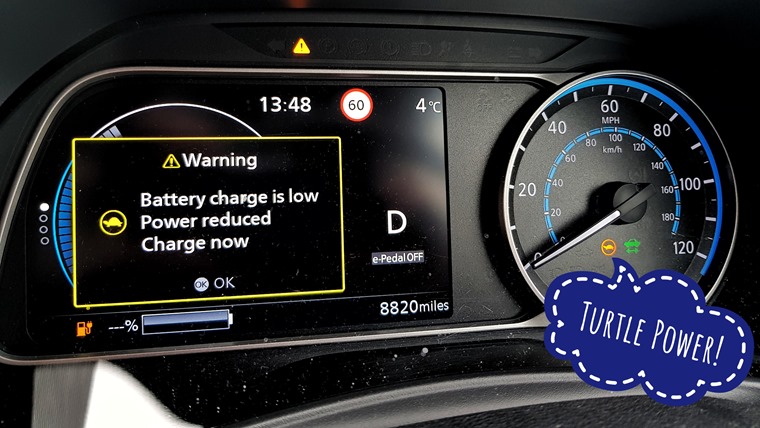
And it carried on for another seven miles, all the time alerting me to impending and certain doom. It was almost like it was angry at me ignoring its dire warnings and daring to carry on. Despite that, there was no loss of power. Performance was still brisk, and the climate control was still running happily.
As the power cut, a thud made itself heard from the motor.
Had I been driving a little more carefully, I’m certain ten miles or more would have been possible before the car gave me notice that it was all about to end. With a sharp jolt, the Leaf activated Turtle Power. This cuts the power available to the bare minimum, allowing you to move at a low speed from a potentially dangerous position to somewhere safer. It also lights up a picture of a turtle on the dashboard, which is nice.
At this point, pressing the throttle down to the floor achieves little. The car crawls along, slowly accelerating to about 20mph. It’s not much, but it might just be enough to get you out of a jam.

The car did this for another three quarters of a mile, until it succumbed to the inevitable. Sharply, and surprisingly roughly, the Leaf died. As the power cut, a thud made itself heard from the motor, and it rotated a couple of times more as momentum kept the car going for a few metres, but this was it. The Leaf was no more.
If you need to push the car to safety, there’s no power steering.
There’s still a traditional car battery on board though, so there’s power to light up the hazard warning lights (and even turn on the radio if you’re not taking this seriously) so you’ll remain safe and visible at the side of the road. However, if you need to push the car to safety, there’s no power steering. Happily, the Leaf freewheels quite well, only getting tricky to shove when the front wheels are turned.
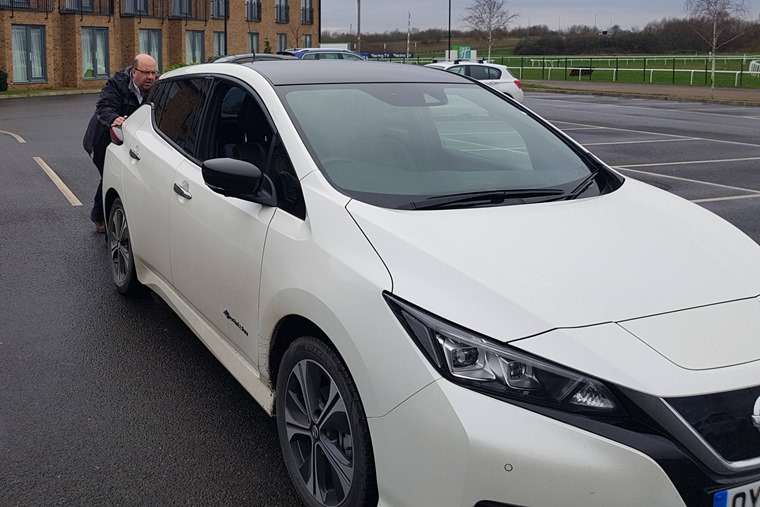
Compare electric home chargers
At this point, you may be wondering how long an extension cable you’ll need to plug into the nearest socket, but each Leaf comes with Nissan’s EV Roadside Assistance. Call the number included in your owner’s manual and Nissan will send a recovery truck out, pull the car onto the flatbed, and take you to the nearest charging facility. It covers you in Europe too, ensuring you’re kept moving regardless of where you travel.
If you do run out of power, it’s not because of a lack of warning.
Other manufacturers provide similar packages, while the likes of AA and RAC also offer breakdown choices that cover out-of-charge situations, so there’s no reason to be left stranded anywhere, no matter how bad your day has gone.
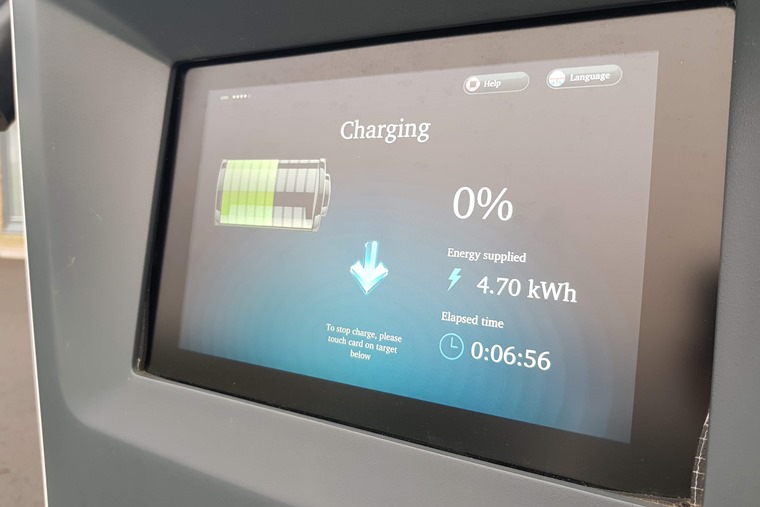
If you do run out of power, it’s not because of a lack of warning. While the estimated range display can be a bit hit and miss, they tend to get more accurate the nearer to zero you get. There’s also countless warnings to alert you to the state of charge, and virtually every EV has a navigation system that will take you to the nearest charger.
In nine months of living with a Nissan Leaf, I’ve got perilously close to running out, but trusted the range readout and each time made it to my destination with some battery charge to spare. The fact that we had to run the car down on purpose to find out what happens shows that the warnings you get, and the growing charging infrastructure, should be enough to keep you on the road.
